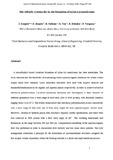- CERES Home
- →
- School of Engineering (SoE)
- →
- Staff publications (SoE)
- →
- View Item
JavaScript is disabled for your browser. Some features of this site may not work without it.
| dc.contributor.author | Gargiuli, J. | |
| dc.contributor.author | Shapiro, Evgeniy | |
| dc.contributor.author | Gulhane, H. | |
| dc.contributor.author | Nair, G. | |
| dc.contributor.author | Drikakis, Dimitris | |
| dc.contributor.author | Vadgama, P. | |
| dc.date.accessioned | 2006-10-02T11:18:12Z | |
| dc.date.available | 2006-10-02T11:18:12Z | |
| dc.date.issued | 2006-10-05 | |
| dc.identifier.citation | Gargiuli J, Shapiro E, Gulhane H, et al., (2006) Microfluidic systems for in situ formation of nylon 6,6 membranes. Journal of Membrane Science, Volume 282, Issues 1-2, October 2006, pp. 257-265 | en |
| dc.identifier.uri | http://hdl.handle.net/1826/1195 | |
| dc.identifier.uri | http://dx.doi.org/10.1016/j.memsci.2006.05.035 | |
| dc.description.abstract | A microfluidics based, localised formation of nylon 6,6 membranes has been undertaken. The study demonstrates the feasibility of maintaining stable aqueous/organic interfaces for xylene within simple linear flow channels. Glass fabricated structures were used with adipoyl chloride and hexamethylenediamine in the organic and aqueous phases, respectively, in order to achieve nylon 6,6 interfacial polymerisation. Localised membrane formation was investigated in flow channels of different geometries over a wide range of flow rates (500–4000 μl/min), with Reynolds numbers ranging from 8.4 to 67.2. The results demonstrate that interfacial polymerisation occurs consistently over a wide range of flow rates and of flow entry angles for dual aqueous/organic solvent input. However, creation of uniform planar film structures required careful optimisation, and these were best achieved at 2000 μl/min with a flow entry angle of 45°. The resulting membranes had thicknesses in the range between 100 and 300 μm. Computational modelling of the aqueous/organic flow was performed in order to characterise flow stability and wall shear-stress patterns. The flow arrangement establishes a principle for the fabrication of micromembrane structures designed for low sample volume separation, where the forming reaction is a facile and rapid interfacial process. | en |
| dc.format.extent | 483780 bytes | |
| dc.format.mimetype | application/pdf | |
| dc.language.iso | en | en |
| dc.publisher | Elsevier | en |
| dc.subject | Microfluidics | en |
| dc.subject | Nylon | en |
| dc.subject | Membranes | en |
| dc.subject | In situ formation | en |
| dc.subject | Interfacial reaction | en |
| dc.title | Microfluidic systems for in situ formation of nylon 6,6 membranes | en |
| dc.type | Article | en |
Files in this item
This item appears in the following Collection(s)
-
Staff publications (SoE) [603]
